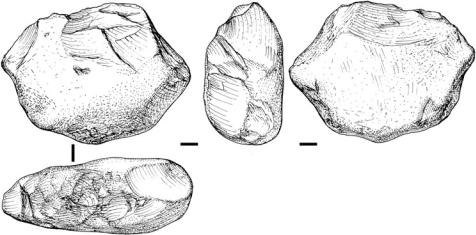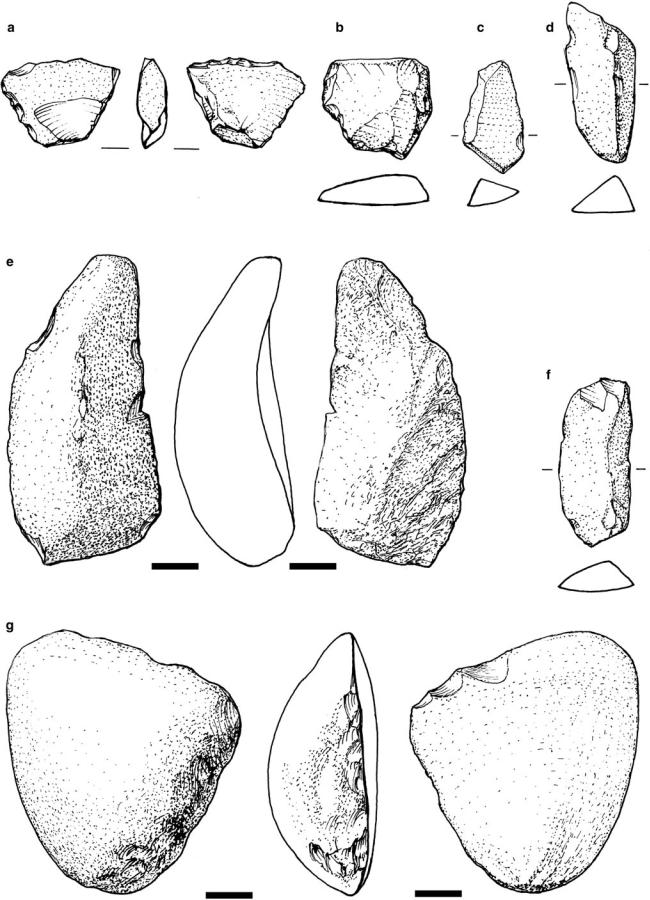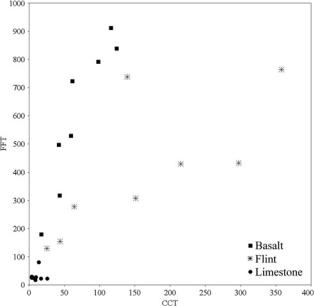
- •Preface
- •Contents
- •Contributors
- •1 The Nature of Culture: Research Goals and New Directions
- •References
- •Abstract
- •The Primitive Tasmanian Image
- •Assessment of a Minimum of Cultural Capacities from a Set of Cultural Performances
- •Conclusions: Lessons from Tasmania
- •References
- •3 Culture as a Form of Nature
- •Abstract
- •The Status Quo of Nature
- •Culture as a Variation of Nature
- •The Dense Context of Nature
- •The Problem of Conscious Inner Space
- •Consciousness as a Social Organ
- •The Meaning of Signs
- •The Role of Written Language
- •References
- •Abstract
- •Introduction
- •Evidence for Animal Social Learning, Traditions and Culture
- •Social Information Transfer
- •Traditions
- •Multiple-Tradition Cultures
- •Cumulative Culture
- •Multiple-Tradition Cultures
- •Cultural Content: Percussive Technology
- •Social Learning Processes
- •Concluding Remarks
- •References
- •Abstract
- •Introduction
- •Typology of Limestone Artifacts
- •Cores and Core-Tools
- •Flakes and Flake-Tools
- •Technology of Limestone Artifacts
- •Cores and Core-Tools
- •Flakes and Flake-Tools
- •Cognitive Abilities
- •Acknowledgements
- •References
- •Abstract
- •Introduction
- •Technological Transformations
- •Cultural Transformations
- •Closing Remarks on the Nature of Homo sapiens Culture
- •Acknowledgements
- •References
- •7 Neanderthal Utilitarian Equipment and Group Identity: The Social Context of Bifacial Tool Manufacture and Use
- •Abstract
- •Introduction
- •Conclusions
- •Acknowledgements
- •References
- •Abstract
- •Introduction
- •Style in the Archaeological Discourse
- •The Archaeological Evidence
- •Discussion and Conclusions
- •Acknowledgements
- •References
- •Abstract
- •Introduction
- •Human Life History
- •Cognitive Development in Childhood
- •The Evolutionary Importance of Play
- •What Is Play?
- •Costs and Benefits of Play
- •Why Stop Playing?
- •Fantasy Play
- •Acknowledgements
- •References
- •Abstract
- •Introduction
- •What Is Culture?
- •Original Definitions
- •Learned Behavior
- •Culture and Material Culture
- •Models of Culture in Hominin Evolution
- •Conclusion
- •Acknowledgments
- •References
- •11 The Island Test for Cumulative Culture in the Paleolithic
- •Abstract
- •Introduction
- •The Island Test for Cumulative Culture
- •Geographic Variation
- •Temporal Variation
- •The Reappearance of Old Forms
- •Conclusions
- •Acknowledgements
- •References
- •12 Mountaineering or Ratcheting? Stone Age Hunting Weapons as Proxy for the Evolution of Human Technological, Behavioral and Cognitive Flexibility
- •Abstract
- •Introduction
- •Single-Component Spears
- •Stone-Tipped Spears
- •Bow-and-Arrow Technology
- •But, Is It Ratcheting?
- •Or Is It Mountaineering?
- •Acknowledgments
- •Index

46 |
N. Alperson-Afil and N. Goren-Inbar |
Fig. 5.4 Limestone chopping tool; note pecking/battering signs on the proximal end (#6038 Layer II-6 Level 4b; scale = 1 cm)
also been used as percussors. It is possible that spontaneous shattering of flakes occurred during use of the percussors, erasing the percussion damage signature (see below). In addition, several artifacts that are split percussors are included within the FFT category.
category. Angular fragments, which occur in very low frequencies, were also included in the CCT category as they cannot be considered flakes.
Chopping Tools
Chopping tools comprise some 12 % of the limestone CCT assemblage (N = 12; Table 5.2). Only a single unifacial chopping tool (i.e., a chopper) was recorded, while the remaining chopping tools exhibit a classic active edge with two platforms (Fig. 5.4). Six of the 12 chopping tools (discussed above) exhibit percussion marks.
Pitted Anvils
Pitted anvils (which are commonly recorded on basalt) occur on limestone artifacts and are identified on both FFTs (N = 3) and CCTs (N = 20). Pitted anvils of the CCT category are all complete and occur mostly on percussors (N = 16), though they were also found on a single “modi- fied” item, a chopping tool, an amorphous core, and a heavy duty scraper. They are mostly cortical, with only one item bearing no cortex, and the majority of items (N = 14) exhibit cortical coverage on 76–100 % of their surface. Their size and shape fall within the relatively large category of percussors (mean dimensions in mm – length: 89.95, width: 76.25, thickness: 53.00, circumference: 271.11).
Cores and Other Core-Tools
In the small sample of seven cores, six were classified as “core varia” and a single one as “amorphous core”. The category of core-tools includes two end-notched pieces, a heavy duty scraper, a cleaver, nine handaxes, and a biface preform (Table 5.2). In addition, the only remnant of a limestone core-waste artifact was recorded within the CCT
Flakes and Flake-Tools
Among limestone flakes and flake-tools the large majority of artifacts, over 70 % in each of the layers, consists of unretouched flakes. The few retouched items (N = 19) include side-scrapers, notches, and a variety of retouched flakes (Table 5.3). The small number of each of the tool types precludes a meaningful typological description. Core-trimming elements are absent.
Technology of Limestone Artifacts
Cores and Core-Tools
Though recorded throughout the occupational sequence of GBY, limestone CCTs occur in very low frequencies, precluding separate in-depth analysis of each archaeological layer. Thus, in order to obtain a meaningful technological description of the limestone component of GBY, we have assembled all limestone CCTs according to major typological groups.
The general characteristics of limestone CCTs suggest that the majority of artifacts are complete, patinated, and abraded or heavily abraded (Table 5.4). By and large, chopping tools and cores exhibit better preservation than percussors and modified artifacts (Table 5.4). This could be correlated with

5 The Limestone of Gesher Benot Ya'aqov |
|
|
|
|
|
|
|
|
47 |
||
Table 5.3 |
Typology of limestone flakes and flake-toolsa; Percentages within layer/level |
|
|
|
|
|
|||||
|
|
|
|
|
|
|
|
|
|
|
|
Typology |
II-2 |
II-5 |
II-6 |
II-6 |
II-6 |
II-6 |
II-6 |
II-6 |
II-6 |
II-6 |
Total |
|
|
|
L1 |
L2 |
L3 |
L4 |
L4b |
L5 |
L6 |
L7 |
|
Side-scrapers |
|
4.55 |
|
|
4.76 |
5.00 |
|
|
|
3 |
|
Typical end-scraper |
|
|
|
4.17 |
|
|
|
|
|
1 |
|
Atypical borer |
|
|
|
|
|
|
|
|
1.30 |
1 |
|
Notch |
|
14.29 |
4.55 |
|
|
4.76 |
5.00 |
3.85 |
|
|
5 |
Denticulate |
|
|
|
|
|
5.00 |
|
|
|
1 |
|
Alternately retouched |
|
|
|
|
|
|
3.85 |
|
|
1 |
|
beaks |
|
|
|
|
|
|
|
|
|
|
|
Retouched flake |
|
9.09 |
|
|
|
5.00 |
|
8.00 |
1.30 |
6 |
|
Naturally backed knife |
|
|
|
|
|
|
|
4.00 |
|
1 |
|
Flake |
100.00 |
85.71 |
81.82 |
76.47 |
87.50 |
71.43 |
70.00 |
88.46 |
84.00 |
93.51 |
213 |
Blade |
|
|
|
|
8.33 |
4.76 |
|
|
|
1.30 |
4 |
Split percussors |
|
|
23.53 |
|
14.29 |
10.00 |
3.85 |
4.00 |
2.60 |
13 |
|
Total |
10 |
7 |
22 |
17 |
24 |
21 |
20 |
26 |
25 |
77 |
249 |
aAssemblages which consist of a minimum number of 10 limestone artifacts (larger than 2 cm)
Table 5.4 General characteristics of limestone cores and core-tools core-tool
Preservation |
Percussors |
|
|
aSplit percussors |
|
Modified |
|
|
Chopping tools |
|
Cores |
|
||
|
|
|
|
|
|
|
||||||||
|
|
|
|
|
|
|||||||||
|
N = 34 |
|
|
N = 13 |
|
|
N = 35 |
|
|
N = 12 |
|
|
N = 7 |
|
|
N |
% |
|
N |
% |
|
N |
% |
|
N |
% |
|
N |
% |
|
|
|
|
|
||||||||||
Fresh |
|
|
|
|
|
|
1 |
2.86 |
|
|
|
1 |
14.29 |
|
Slightly abraded |
11 |
32.35 |
2 |
15.38 |
|
8 |
22.86 |
7 |
58.33 |
2 |
28.57 |
|||
Abraded |
21 |
61.76 |
4 |
30.77 |
|
24 |
68.57 |
5 |
41.67 |
4 |
57.14 |
|||
Heavily abraded |
1 |
2.94 |
5 |
38.46 |
|
2 |
5.71 |
|
|
|
|
|
|
|
Exfoliated/decayed |
1 |
2.94 |
2 |
15.38 |
|
|
|
|
|
|
|
|
|
|
Patina |
|
|
|
|
|
|
|
|
|
|
|
|
|
|
Patina |
31 |
91.18 |
12 |
92.31 |
|
35 |
100.00 |
10 |
83.33 |
5 |
71.43 |
|||
Double patina |
3 |
8.82 |
1 |
7.69 |
|
|
|
2 |
16.67 |
2 |
28.57 |
|||
Breakage |
|
|
|
|
|
|
|
|
|
|
|
|
|
|
Complete |
31 |
91.18 |
|
|
|
|
32 |
91.43 |
12 |
100.00 |
7 |
100.00 |
||
Lateral |
1 |
2.94 |
|
|
|
|
3 |
8.57 |
|
|
|
|
|
|
Distal |
1 |
2.94 |
|
|
|
|
|
|
|
|
|
|
|
|
Distal and proximal |
1 |
2.94 |
|
|
|
|
|
|
|
|
|
|
|
|
Split |
|
|
13 |
100.00 |
|
|
|
|
|
|
|
|
||
Cortex |
N = 32 |
|
|
N = 13 |
|
|
N = 33 |
|
|
N = 12 |
|
|
N = 7 |
|
None |
|
|
|
|
|
|
2 |
6.06 |
|
|
|
2 |
28.57 |
|
1–25 % |
|
|
|
|
|
|
3 |
9.09 |
|
|
|
2 |
28.57 |
|
26–50 % |
1 |
2.94 |
1 |
7.69 |
|
4 |
12.12 |
2 |
16.67 |
1 |
14.29 |
|||
51–75 % |
3 |
9.38 |
1 |
7.69 |
|
5 |
15.15 |
6 |
50.00 |
1 |
14.29 |
|||
76–100 % |
28 |
87.50 |
11 |
84.62 |
|
19 |
57.58 |
4 |
33.33 |
1 |
14.29 |
|||
aNote split percussors, included in the FFT category, are presented here due to their technological nature
cortical coverage, where abrasion predominates and which covers larger areas in the two latter categories (the “cortex” is but the outer face of the limestone cobbles).
An interesting pattern emerges from the characteristics of different categories of cores and core-tools. First, as expected, percussors exhibit the highest frequencies of cortical coverage, which decreases gradually from modified artifacts to chopping tools and then to cores (Table 5.4). As for breakage patterns, chopping tools and cores are all complete,
while breakage is seen on 8.82 % of the percussors. Interestingly, double-patinated items also gradually increase from 8.82 % of percussors, through 16.67 % of chopping tools, to 28.57 % of cores (Table 5.4). Such “gradual” changes are also seen in the metric measurements of these categories: percussors are generally longer, wider, and thicker than chopping tools, which are generally longer, wider, and thicker than cores (Table 5.5). The circumference of these categories decreases similarly (Table 5.5).

48 |
N. Alperson-Afil and N. Goren-Inbar |
Flakes and Flake-Tools
Flakes and flake-tools are extensively patinated, though the frequency of double patination is markedly low (Table 5.6). While this taphonomic situation depends on exposure to atmospheric condition, the preservation of the FFTs at GBY is mainly determined by in situ chemical processes that affect the limestone and cause very high frequencies of abraded surfaces, though with internal variation, as shown in Table 5.6.
A trait shared by most of the limestone flaked pieces is the presence of cortex on the dorsal face (Table 5.6). Examination of the extent of cortical coverage suggests that most artifacts exhibit cortical coverage of 75 % on their dorsal face (Table 5.7). Correspondingly, when the number of dorsal scars on limestone flakes is examined, it is evident that the preceding knapping involved very few removals, with an average of no more than four flake removals (Table 5.8).
Table 5.5 Descriptive statistics of limestone cores and core-tools
|
Percussors |
Split percussors |
Modified |
Chopping tools |
Cores |
Maximum |
(N = 34) |
(N = 13) |
(N = 35) |
(N = 12) |
(N = 7) |
Maximum |
123 |
123 |
125 |
108 |
109 |
Median |
96 |
97 |
65 |
95.50 |
67 |
Minimum |
64 |
72 |
33 |
55 |
31 |
Mean |
95.85 |
98.61 |
70.62 |
89.92 |
69.85 |
Std dev |
12.50 |
14.85 |
26.66 |
18.68 |
32.01 |
Std err mean |
2.14 |
4.11 |
4.50 |
5.39 |
12.09 |
Length |
|
|
|
|
|
Maximum |
120 |
114 |
206 |
106 |
103 |
Median |
91 |
89 |
70 |
88.50 |
64 |
Minimum |
55 |
60 |
30 |
25 |
25 |
Mean |
90.76 |
83.69 |
71.65 |
81.75 |
62.42 |
Std dev |
15.65 |
16.66 |
35.13 |
24.81 |
31.38 |
Std err mean |
2.68 |
4.62 |
5.93 |
7.16 |
11.86 |
Width |
|
|
|
|
|
Maximum |
94 |
117 |
96 |
100 |
90 |
Median |
76 |
76 |
46 |
73.50 |
60 |
Minimum |
53 |
57 |
23 |
52 |
27 |
Mean |
75.05 |
82.92 |
53.08 |
73.25 |
56.28 |
Std dev |
11.44 |
18.57 |
22.33 |
14.12 |
23.97 |
Std err mean |
1.96 |
5.15 |
3.77 |
4.08 |
9.05 |
Thickness |
|
|
|
|
|
Maximum |
79 |
61 |
68 |
65 |
49 |
Median |
52 |
36 |
29 |
46 |
25 |
Minimum |
37 |
22 |
15 |
37 |
18 |
Mean |
52.70 |
37.61 |
36.00 |
48.25 |
32.00 |
Std dev |
11.04 |
10.57 |
16.01 |
10.30 |
12.32 |
Std err mean |
1.89 |
2.93 |
2.70 |
2.97 |
4.65 |
Circumference |
(N = 24) |
(N = 13) |
(N = 6) |
(N = 9) |
(N = 7) |
Maximum |
335 |
339 |
349 |
325 |
303 |
Median |
276 |
267 |
237 |
295 |
205 |
Minimum |
98 |
210 |
113 |
154 |
91 |
Mean |
270.13 |
272.61 |
233.83 |
264.67 |
198.00 |
Std dev |
50.97 |
34.70 |
82.05 |
60.69 |
85.72 |
Std err mean |
10.40 |
9.62 |
33.49 |
20.23 |
32.40 |
aNumber of scars |
(N = 20) |
(N = 9) |
(N = 35) |
(N = 12) |
(N = 7) |
Maximum |
8 |
6 |
4 |
12 |
20 |
Median |
2.50 |
2 |
2 |
7 |
4 |
Minimum |
1 |
1 |
1 |
2 |
3 |
Mean |
2.95 |
2.66 |
2.22 |
7.08 |
6.71 |
Std dev |
2.03 |
1.41 |
0.84 |
3.32 |
5.99 |
Std err mean |
0.45 |
0.47 |
0.14 |
0.96 |
2.26 |
Sum |
59 |
24 |
78 |
85 |
47 |
aExcluded from the counts are items without scars

Table 5.6 |
General characteristics of limestone flakes and flake-tools; percentages (top) and counts (bottom) |
|
|
|
|
|
|
|
|
||||||||
|
|
|
|
|
|
|
|
|
|
|
|
|
|
|
|
|
|
Layer |
|
Patina |
|
|
|
Preservation |
|
|
|
|
Breakage |
|
|
|
Cortex |
|
Total |
|
|
|
|
|
|
|
|
|
|
|
|||||||
|
|
|
|
|
|
|
|
|
|
|
|
||||||
|
|
|
|
|
|
|
|
|
|
|
|
|
|
|
|
|
|
|
|
None |
Patina |
Double |
|
Fresh |
Slightly abraded |
Abraded |
Heavily abraded |
|
Complete |
Broken |
|
|
None |
Cortex |
|
|
|
|
|
|
|
||||||||||||
|
|
|
|
|
|
|
|
|
|
|
|
|
|
|
|
|
|
II-2 |
|
– |
80.00 |
20.00 |
|
– |
20.00 |
40.00 |
40.00 |
60.00 |
40.00 |
50.00 |
50.00 |
10 |
|||
|
|
|
(8) |
(2) |
|
|
(2) |
(4) |
(4) |
(6) |
(4) |
(5) |
(5) |
|
|||
II-5 |
28.57 |
57.14 |
14.28 |
14.28 |
14.28 |
57.14 |
14.28 |
71.43 |
28.57 |
14.28 |
85.71 |
7 |
|||||
|
(2) |
(4) |
(1) |
(1) |
(1) |
(4) |
(1) |
(5) |
(2) |
(1) |
(6) |
|
|||||
II-6/L1 |
13.63 |
77.27 |
9.09 |
13.63 |
13.63 |
59.09 |
13.63 |
59.09 |
40.90 |
50.00 |
50.00 |
22 |
|||||
|
(3) |
(17) |
(2) |
(3) |
(3) |
(13) |
(3) |
(13) |
(9) |
(11) |
(11) |
|
|||||
II-6/L2 |
5.88 |
88.23 |
5.88 |
5.88 |
23.52 |
52.94 |
17.64 |
52.94 |
47.05 |
35.29 |
64.70 |
17 |
|||||
|
(1) |
(15) |
(1) |
(1) |
(4) |
(9) |
(3) |
(9) |
(8) |
(6) |
(11) |
|
|||||
II-6/L3 |
|
– |
95.83 |
4.16 |
8.33 |
29.16 |
45.83 |
16.66 |
50.00 |
50.00 |
45.83 |
54.16 |
24 |
||||
|
|
|
(23) |
(1) |
(2) |
(7) |
(11) |
(4) |
(12) |
(12) |
(11) |
(13) |
|
||||
II-6/L4 |
4.76 |
90.47 |
4.76 |
19.04 |
28.57 |
38.09 |
14.28 |
52.38 |
47.61 |
28.57 |
71.42 |
21 |
|||||
|
(1) |
(19) |
(1) |
(4) |
(6) |
(8) |
(3) |
(11) |
(10) |
(6) |
(15) |
|
|||||
II-6/L4b |
5.00 |
85.00 |
10.00 |
|
– |
15.00 |
35.00 |
50.00 |
55.00 |
45.00 |
30.00 |
70.00 |
20 |
||||
|
(1) |
(17) |
(2) |
|
|
(3) |
(7) |
(10) |
(11) |
(9) |
(6) |
(14) |
|
||||
II-6/L5 |
|
– |
80.76 |
19.23 |
|
– |
7.69 |
23.07 |
69.23 |
42.30 |
57.69 |
38.46 |
61.53 |
26 |
|||
|
|
|
(21) |
(5) |
|
|
(2) |
(6) |
(18) |
(11) |
(15) |
(10) |
(16) |
|
|||
II-6/L6 |
12.00 |
80.00 |
8.00 |
|
– |
44.00 |
52.00 |
4.00 |
24.00 |
76.00 |
28.00 |
72.00 |
25 |
||||
|
(3) |
(20) |
(2) |
|
|
(11) |
(13) |
(1) |
(6) |
(19) |
(7) |
(18) |
|
||||
II-6/L7 |
5.19 |
92.20 |
2.59 |
1.29 |
7.79 |
33.76 |
57.14 |
35.06 |
64.93 |
28.57 |
71.42 |
77 |
|||||
|
(4) |
(71) |
(2) |
(1) |
(6) |
(26) |
(44) |
(27) |
(50) |
(22) |
(55) |
|
|||||
Ya'aqov Benot Gesher of Limestone The 5
49
50 |
|
|
|
|
|
N. Alperson-Afil and N. Goren-Inbar |
|
Table 5.7 |
Extent of cortical coverage on limestone flakes and flake-tools; percentages (top) and counts (bottom) |
|
|||||
|
|
|
|
|
|
|
|
Layer |
No cortex |
1–25 % |
26–50 % |
51–75 % |
76–100 % |
Indet. |
Total |
II-2 |
50.00 |
– |
– |
– |
40.00 |
10.00 |
10 |
|
(5) |
|
|
|
(4) |
(1) |
|
II-5 |
14.28 |
– |
14.28 |
14.28 |
57.14 |
– |
7 |
|
(1) |
|
(1) |
(1) |
(4) |
|
|
II-6/L1 |
50.00 |
4.54 |
– |
4.54 |
36.36 |
4.54 |
22 |
|
(11) |
(1) |
|
(1) |
(8) |
(1) |
|
II-6/L2 |
35.29 |
17.64 |
– |
5.88 |
41.17 |
– |
17 |
|
(6) |
(3) |
|
(1) |
(7) |
|
|
II-6/L3 |
45.83 |
12.50 |
12.50 |
4.16 |
16.66 |
8.33 |
24 |
|
(11) |
(3) |
(3) |
(1) |
(4) |
(2) |
|
II-6/L4 |
28.57 |
9.52 |
9.52 |
14.28 |
33.33 |
4.76 |
21 |
|
(6) |
(2) |
(2) |
(3) |
(7) |
(1) |
|
II-6/L4b |
30.00 |
5.00 |
20.00 |
– |
35.00 |
10.00 |
20 |
|
(6) |
(1) |
(4) |
|
(7) |
(2) |
|
II-6/L5 |
38.46 |
– |
– |
7.69 |
30.76 |
23.07 |
26 |
|
(10) |
|
|
(2) |
(8) |
(6) |
|
II-6/L6 |
28.00 |
4.00 |
8.00 |
4.00 |
4.00 |
52.00 |
25 |
|
(7) |
(1) |
(2) |
(1) |
(1) |
(13) |
|
II-6/L7 |
28.57 |
1.29 |
5.19 |
– |
25.97 |
38.96 |
77 |
|
(22) |
(1) |
(4) |
|
(20) |
(30) |
|
Total |
(85) |
(12) |
(16) |
(10) |
(70) |
(56) |
249 |
Breakage patterns vary amongst assemblages, with a general majority of complete items in most layers (Table 5.6). Nevertheless, fragmented items and distal and proximal breaks are common (Table 5.9). The breakage patterns are not associated with the preservation or patination state of the limestone artifacts, or with their size; consequently, it is possible that these patterns result from spontaneous breakage (i.e., percussor shattering) during the knapping process (Figs. 5.3 and 5.5).
Analyses of the limestone FFTs resulted in several observations that seem to characterize all the examined assemblages and can be summarized as follows:
(1)The frequency of limestone FFTs is relatively low in comparison with other raw materials.
(2)Complete limestone FFTs characterize most layers, though fragmented items and distal and proximal breaks are common in all archaeological horizons.
(3)The vast majority of limestone FFTs consists of unretouched flakes.
(4)Limestone FFTs are small in size with very similar
mean length and width (i.e., somewhat rounded, non-elongated, flakes) (Table 5.8).
(5)Limestone core trimming elements are absent from the assemblages.
(6)The number of dorsal scars and the extent of cortical coverage imply that most limestone FFT production was carried out during the early stages of decortication.
From these patterns, no standardized industry of limestone FFT production can be identified at GBY. Rather, limestone FFTs seem to exhibit characteristics of byproducts
of limestone core-tool production. In order to evaluate the entire sequence of limestone knapping at the site, we should look within the CCT category for the possible contributors of the limestone flake component.
Discussion: The Limestone Reduction
Sequence
In comparison to the other raw materials used by the GBY Acheuleans, the limestone assemblage exhibits a different utilization mode and approach (Fig. 5.6). While basalt and flint consistently exhibit higher frequencies of flakes/ flake-tools than cores/core-tools, as well as varying ratios of these two categories throughout the archaeological sequence, the utilization of limestone seems to be fairly uniform throughout the sequence, with low frequencies of limestone artifacts and a ratio of cores/core-tools to flakes/flake-tools closer to 2 (Fig. 5.6). Even before systematic examination of the limestone component, these patterns clearly indicate a particular exploitation mode in which flakes/flake-tools are not the main target products.
Within the examined sample (i.e., originating in the excavated archaeological horizons: Layers II-2, II-5, II-6 Levels 1–7), the number of limestone FFTs (N = 247) and the number of observed scars on the CCTs (N = 261) are very similar. This similarity indicates that there is no shortfall of flakes that could have originated in the knapping of CCTs. Furthermore, it suggests that the limestone FFTs were the products of in situ knapping and utilization. If the limestone

5 The Limestone of Gesher Benot Ya'aqov |
51 |

52 |
N. Alperson-Afil and N. Goren-Inbar |
bFig. 5.5 Limestone FFTs (a #9633 Layer II-6 Level 5; b #13311 Layer II-6 Level 3; c #1693 Layer II-6 Level 4b; d #14322 Layer II-6 Level 7; e #4329 Layer II-6 Level 6; f #2100 Layer II-6 Level 4; g #3440 Layer II-6 Level 4b; scale = 1 cm)
Table 5.8 Descriptive statistics of limestone flakes and flake-tools
|
II-2 |
II-5 |
II-6 |
II-6 |
II-6 |
II-6 |
II-6 |
II-6 |
II-6 |
II-6 |
|
|
|
L1 |
L2 |
L3 |
L4 |
L4b |
L5 |
L6 |
L7 |
Maximum |
|
|
|
|
|
|
|
|
|
|
Maximum |
41 |
82 |
76 |
117 |
64 |
144 |
91 |
113 |
93 |
110 |
Median |
27.50 |
38 |
32 |
31 |
32.50 |
34 |
30.50 |
26 |
29 |
28 |
Minimum |
21 |
33 |
23 |
22 |
22 |
22 |
20 |
20 |
21 |
21 |
Mean |
28.80 |
47.57 |
34.86 |
47.17 |
35.70 |
48.38 |
39.60 |
29.76 |
33.28 |
33.10 |
Std dev |
7.28 |
18.63 |
12.83 |
30.27 |
12.12 |
34.66 |
21.41 |
17.59 |
16.13 |
15.38 |
Std err mean |
2.30 |
7.04 |
2.73 |
7.34 |
2.47 |
7.56 |
4.78 |
3.45 |
3.22 |
1.75 |
Flaking length |
|
|
|
|
|
|
|
|
|
|
Maximum |
38 |
82 |
57 |
93 |
64 |
144 |
89 |
107 |
93 |
93 |
Median |
24.50 |
35 |
24.50 |
28 |
30 |
31 |
29.50 |
24.50 |
22 |
25 |
Minimum |
15 |
24 |
18 |
21 |
20 |
15 |
15 |
17 |
15 |
12 |
Mean |
26.20 |
42.57 |
28.59 |
39.47 |
32.91 |
43.28 |
36.35 |
28.03 |
28.56 |
28.74 |
Std dev |
8.18 |
19.26 |
9.66 |
21.18 |
11.24 |
32.78 |
21.94 |
16.97 |
16.95 |
13.62 |
Std err mean |
2.58 |
7.27 |
2.06 |
5.13 |
2.29 |
7.15 |
4.90 |
3.32 |
3.39 |
1.57 |
Flaking width |
|
|
|
|
|
|
|
|
|
|
Maximum |
31 |
61 |
72 |
117 |
51 |
106 |
69 |
96 |
66 |
107 |
Median |
23 |
34 |
26 |
29 |
25 |
29 |
25.50 |
18 |
23 |
23 |
Minimum |
19 |
19 |
17 |
14 |
14 |
11 |
14 |
13 |
15 |
10 |
Mean |
24.60 |
37.42 |
31.09 |
38.76 |
27.37 |
37.28 |
30.55 |
22.07 |
26.04 |
26.00 |
Std dev |
4.64 |
16.08 |
13.03 |
29.95 |
10.29 |
27.05 |
16.74 |
15.80 |
11.54 |
14.47 |
Std err mean |
1.46 |
6.07 |
2.77 |
7.26 |
2.10 |
5.90 |
3.74 |
3.09 |
2.30 |
1.67 |
Thickness |
|
|
|
|
|
|
|
|
|
|
Maximum |
14 |
39 |
22 |
43 |
27 |
61 |
44 |
53 |
36 |
45 |
Median |
9 |
12 |
12.50 |
15 |
12 |
13 |
10.50 |
9.50 |
9 |
10 |
Minimum |
8 |
9 |
7 |
7 |
5 |
8 |
7 |
4 |
6 |
4 |
Mean |
9.8 |
18.28 |
13.40 |
17.29 |
13.29 |
17.42 |
15.65 |
10.76 |
11.52 |
12.44 |
Std dev |
2.09 |
10.87 |
4.53 |
11.07 |
6.58 |
12.98 |
10.13 |
8.91 |
6.71 |
7.26 |
Std err mean |
0.66 |
4.10 |
0.96 |
2.68 |
1.34 |
2.83 |
2.26 |
1.74 |
1.34 |
0.82 |
N |
10 |
7 |
22 |
17 |
24 |
21 |
20 |
26 |
25 |
77 |
Number of scars |
|
|
|
|
|
|
|
|
|
|
Maximum |
3 |
2 |
8 |
6 |
9 |
5 |
4 |
4 |
6 |
8 |
Median |
1.50 |
2 |
3 |
2.50 |
2 |
2.50 |
3 |
3 |
4 |
2 |
Minimum |
1 |
1 |
1 |
1 |
1 |
1 |
1 |
1 |
2 |
1 |
Mean |
1.83 |
1.60 |
3.91 |
2.66 |
3.12 |
2.64 |
2.38 |
2.83 |
3.71 |
2.68 |
Std dev |
0.98 |
0.54 |
2.46 |
1.66 |
2.60 |
1.27 |
1.12 |
1.16 |
1.49 |
1.56 |
Std err mean |
0.40 |
0.24 |
0.71 |
0.48 |
0.65 |
0.34 |
0.31 |
0.47 |
0.56 |
0.28 |
aN |
6 |
5 |
12 |
12 |
16 |
14 |
13 |
6 |
7 |
29 |
aCounts exclude cortical flakes with no scars
reduction sequence was oriented towards the production of flakes and flake-tools, one would expect their number to exceed the observed number of scars on the CCTs. However, considering the great similarity of the two values, the characteristics of the FFTs (i.e., cortical, non-retouched, small-sized), and the dominance of percussors in these assemblages, it is most probable that the limestone flakes originate primarily from battering and accidental shattering as a result of the use of limestone percussors. In each of the archaeological horizons, the pattern is more variable. In some assemblages the number of observed scars on CCTs is
smaller than the number of FFTs and in other layers it is larger. The presence and frequencies of limestone microartifacts in each of these layers extend the observed variability.
Thus, percussors and modified artifacts form the majority of limestone core-tools, and these categories display similar patterns of breakage and cortical coverage, with a majority of complete items and a particularly high cortical coverage (Table 5.4). In terms of metric dimensions, however, there is a general similarity in size between percussors and chopping tools. This similarity may suggest that limestone pebbles were selected to fit a particular size and form (i.e., fist size). The

5 The Limestone of Gesher Benot Ya'aqov |
|
|
|
|
|
|
53 |
||||
Table 5.9 |
Breakage patterns of limestone flakes and flake-tools; percentages (top) and counts (bottom) |
|
|
|
|
||||||
|
|
|
|
|
|
|
|
|
|
|
|
Layer |
Complete |
Distal |
Proximal |
Distal and |
Distal and |
Proximal and |
Lateral |
Fragment |
Indet. |
Split |
Total |
|
|
|
|
proximal |
lateral |
lateral |
|
|
|
|
|
II-2 |
60.00 |
– |
– |
10.00 |
20.00 |
– |
10.00 |
– |
– |
– |
10 |
|
(6) |
|
|
(1) |
(2) |
|
(1) |
|
|
|
|
II-5 |
71.43 |
28.57 |
– |
– |
– |
– |
– |
– |
– |
– |
7 |
(5)(2)
II-6/L1 |
59.09 |
27.27 |
– |
4.54 |
– |
– |
4.54 |
4.54 |
– |
– |
22 |
|
(13) |
(6) |
|
(1) |
|
|
(1) |
(1) |
|
|
|
II-6/L2 |
52.94 |
– |
5.88 |
– |
– |
5.88 |
– |
11.76 |
– |
23.52 |
17 |
|
(9) |
|
(1) |
|
|
(1) |
|
(2) |
|
(4) |
|
II-6/L3 |
50.00 |
4.16 |
20.83 |
– |
4.16 |
4.16 |
4.16 |
12.50 |
– |
– |
24 |
|
(12) |
(1) |
(5) |
|
(1) |
(1) |
(1) |
(3) |
|
|
|
II-6/L4 |
52.38 |
4.76 |
4.76 |
– |
– |
4.76 |
– |
14.28 |
4.76 |
14.28 |
21 |
|
(11) |
(1) |
(1) |
|
|
(1) |
|
(3) |
(1) |
(3) |
|
II-6/L4b |
55.00 |
10.00 |
10.00 |
– |
– |
– |
5.00 |
10.00 |
|
10.00 |
20 |
|
(11) |
(2) |
(2) |
|
|
|
(1) |
(2) |
|
(2) |
|
II-6/L5 |
42.30 |
15.38 |
3.84 |
|
|
|
|
30.76 |
3.84 |
3.84 |
26 |
|
(11) |
(4) |
(1) |
|
|
|
|
(8) |
(1) |
(1) |
|
II-6/L6 |
24.00 |
8.00 |
16.00 |
4.00 |
|
|
16.00 |
28.00 |
– |
4.00 |
25 |
|
(6) |
(2) |
(4) |
(1) |
|
|
(4) |
(7) |
|
(1) |
|
II-6/L7 |
35.06 |
12.98 |
9.09 |
2.59 |
10.39 (8) |
2.59 |
7.79 |
16.88 |
– |
2.59 |
77 |
|
(27) |
(10) |
(7) |
(2) |
|
(2) |
(6) |
(13) |
|
(2) |
|
Total |
(111) |
(28) |
(21) |
(5) |
(11) |
(5) |
(14) |
(39) |
(2) |
(13) |
249 |
Fig. 5.6 Counts of cores and core-cools (excluding bifaces) and flakes and flake-tools from the 8 levels of Layer II-6 (Levels 1–7) by different raw materials
slight size gradient in several metric characteristics of these two categories enables a general reconstruction of the “lifetime” of the limestone pebble – first as a percussor (larger, more cortical, fewer scars), and then, possibly after spontaneous breakage of the utilized percussor, modification into a chopping tool (slightly smaller, less cortical, more scars, more frequently double patinated). Finally, the concluding stage in
this limestone chaîne opératoire may possibly be the transformation of a chopping tool into a core – smallest, less cortical, and even more frequently double patinated.
A classic reduction sequence is determined by a succession of procedures, which generally begin with procurement of the raw material and terminate with production of the desired end product, its use, and finally its discard. The GBY limestone component, however, presents a dynamic reduction sequence in which the desired end product (i.e., a percussor) is actually the starting point of the sequence (Fig. 5.7).
Such a flexible and dynamic operational sequence is an indication of long-term planning and hence advanced cognitive abilities (see below), expressed in an intentional selection of the limestone raw material that involved decisions about the future function and therefore dictated the size/dimensions of the selected pebble/nodule. From the very first stages of the limestone reduction sequence, the mobility of artifacts from their sedimentary source (fluvial terraces) necessitated means of transporting the limestone pebbles/ nodules – means that were different from those used for the basalt slabs (Goren-Inbar 2011b).
The hominins of GBY apparently had a deep understanding of the association between the characteristics of raw materials and their particular mode of exploitation in the different reduction sequences. Since basalt percussors occur in GBY at even higher frequencies than those of limestone, one may ask what were the specific qualities of limestone that made its use desirable. Clearly, the basalt percussors differ in qualities from those of limestone, the latter being a softer stone. Studies concerned with the qualities of limestone percussors illustrate the fact that
